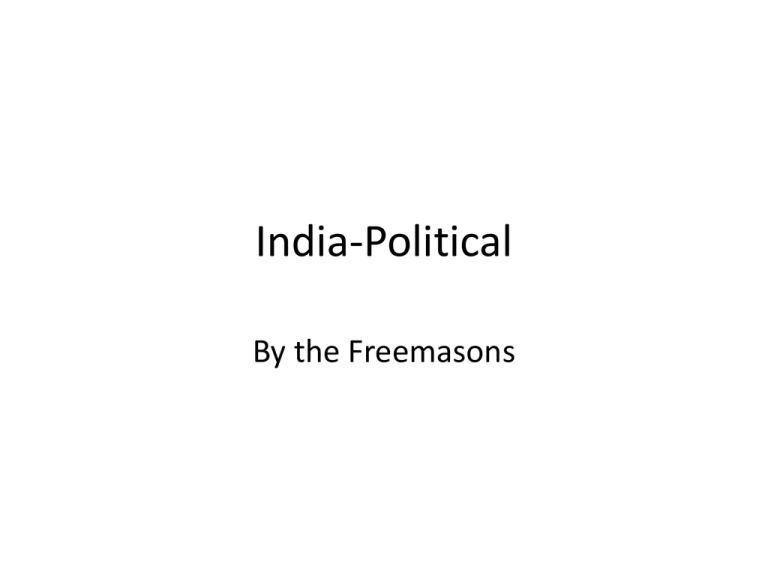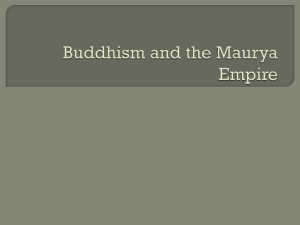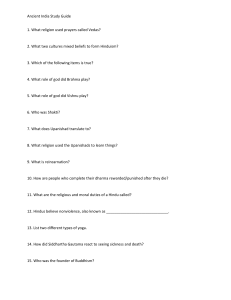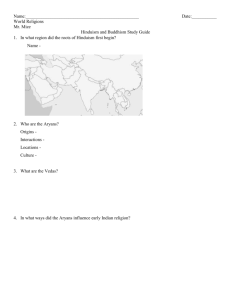India-Political - Lyons-AP
advertisement

India-Political By the Freemasons Kushan State • Vast trade with Europe • Use of monsoon winds to facilitate trade with Europe • Establishment of Roman colonies along trade routes from Indian Ocean and Mediterranean • Exported cotton, ivory, indigo, pepper, and textiles Kushan State - Continued • Spread of Buddhism • Buddhist monasteries and stupas across trade routes • Fell to the Sassanids (Persians) and Gupta Gupta • Came into power 320 CE • Dominant political force in India – Still fragmented • Capital at Pataliputra • Most powerful state in India since the Mauryan power Gupta - continued • Prosperity under Chandragupta II and Samudragupta – Greatly expanded empire to the height of power • Trade with China, Southeast Asia, and Mediterranean – controlled by government • Coinage – Coins from the Middle East led to banking – Barter transactions (mainly) Chandragupta II Gupta – Golden Age • • • • • • Development of “Arabic” Numbers The number zero Decimals Smallpox vaccine Buddhist stupas Plastic surgery The Fall of the Guptas • Hunas – Nomadic warriors from the northwest • India returns to small regional kindoms – Competition with political fragmentation • Further supported Islamic success in India Cola Kingdom • Located in the south eastern coast India • Heartland of Cholas in the fertile valley of the Kaveri River. • The lasting legacy is literature and zeal of building temples Cola(Cholas) Kingdom • • • • • Cholas kingdom dominated the SE Asia trade in the 9th century trading partners China, Addassids, Malayan archipelago Cholas spread Hinduism, and Dravidian culture to SE Asia Cholas kingdom on the Kaveri river southern India The kingdom Monarchy and local government based of self-governing unit. Village entity known as Kurram, Kurram entity known as Valandu. Justice local level crimes payed in fines but crimes against the state were heard by the king. •A section to the empire of Asoka which lasted after the empire fell •Held off the Islamic invaders from the Delhi sultanate. •In 1010CE to 1200CE went on Military campaigns •In 13th century the Pandayas steadily routed the Cholas in to destruction Delhi Sultanate • • • • • • • • Several Islamic Turkic and Afghan Dynasties Muhammad Ghori who started a Ghorid Dynasty in 1193CE consolidated his power at Delhi He appointed Turkish generals like Qutb Aybak ruler of the region in India. Mamluks ( slave dynasty ) where military slaves.Ater Ghori's death Aybak took control. The Dynasty known for administration and centralized stability over the region. 1221CE the Mongols launched military campaigns were kept back out of India Timur weakened Delhi in 1398CE Mongol Empire broke up and for some year the threat of the Mongols were weakened Under the Lodi Dynasty Delhi Sultanate revived In 1526CE emperor of the Mughal Babur conquered Delhi Sultanate Tamerlane • Wanted to restore old Mongol empire. • Founder of Timurid empire and dynasty. • Militaristic • Patron of the arts • Muslim – destroys lots of the Christian church in Asia • Used propaganda • CONQUERS GOLDEN HORDE!!!!!! Campaigns • Attacked Persia • Destroyed cities and towns - brought chaos • Golden Horde attacks Timur • Timur conquers the Golden Horde – Destroys capital – Ruins Horde’s economy Campaigns pt. 2 • Then turns his attention to India • Easily conquers the Hindu Indians – Sacks and burns cities – Kills civilians and prisoners – Great strategy – uses camels to scare elephants Indian Economics By: WHAP Warriors Trade Routes • Silk Road passed through northern India. • Most trade regulated by government • Powerful caste guilds monopolized parts of trade. Main exports were ivory, indigo, textiles, precious stones, and pepper Samarkand • Came under Muslim rule in early 8th century (previously was capital of Persian province) • Important trade center between China and Mediterranean • Contains mosques dating from early 14th century Centrally located on the silk road which allowed trade to flourish. Government Owned Mines • Vast crown lands • Massive profits were earned from their commercial dealings • Almost all of economy was regulated through government Caste Guilds • Trade dominated by great caste guilds that monopolized key sectors of the economy • Leaders possessed most wealth • Acted as bankers Fa Xian • Chinese Buddhist missionary • Visited India in the MidGupta era • Searched for Buddhist documents • Majority of current knowledge of medieval India comes from Chinese missionaries Other Facts • Money economy in operation since 2nd century B.C.E. • Traded with China, SE Asia, and Mediterranean • Merchants were highly respected • Copper coins and idea of banking were developed India- Religion and Art Golden Horde Theravada Buddhism Mahayana Buddhism vs. Members of a homogeneous community of faith and worship, built on notion Buddha was human being who taught by example • Belong to a wide variety of subcommunities • Scriptures evolved in many languages as the tradition moved through Asia • Main scriptures are the Pali Canon • • Seek deliverance from rebirth by eliminating craving and ignorance through self discipline Teachings universalized a number of classical Buddhist concepts, expanding religious options • Buddha was a spiritual presence • Teachings expanded further by personifying wisdom as a feminine principle • Developed the concept of “emptiness” or shunyata as a way of emphasizing the futility of clinging to anything at all • • The model of the enlightened life is the arhat • Nirvana is ultimate goal, believed to be a permanent state of knowledge, freedom and peace as result of personal effort Theravada Buddhism Mahayana Buddhism vs. “Great vehicle” “Wisdom of the Elders” • • • • Primary intent during praying is to honor the Buddha more than to worship him All good acts can gain merit toward eradication of negative karma Merit making and transfer are more basic than the ethical discipline embodied in an arhat Some regional and cultural variations in Theravada, but less than in other main branches • One Mahayana school is the Pure Land communities • Amitabha (a meditational Buddha) rules the western paradise or the Pure Land • Chan lineages have been influential also • Soto school emphasizes quiet, methodical meditation • Rinzai school uses in addition the mind-stopping device called the koan to hasten the experience of enlightenment Spread of Theravada Spread of Mahayana 25 Collapse of Buddhism • Hinduism starts to have a resurgence • Undermined traditional Hindu beliefs, and went against caste system • Declined, due to Muslim invasions Islam in India • Muslim leaders were tolerant of Hinduism and Buddhism • Many Hindu’s converted to escape the caste system • Role of Hindu women stayed the same (sati was still practiced) • Purdah- isolation of Muslim women Sikhism • Founded by Guru Nanak in the 1500’s • Gained popularity in northwestern India • • Tried to integrate Islam with Hinduism but created conflict Became an alternative religion Sikhism Beliefs • Believe that God was the only true reality • Don’t agree with caste system, sati, etc. • Believe in equality for races and sexes Art, Literature, & Music • • • Art Buddhist temples and monasteries • • Built in caves 28 caves of Ajanta Starting in the 8th century above ground temples were built • • • • Art, Literature, & Music Literature Large number of written works, both secular, and religious • Written in Sanskrit Much of the religious works talked about the lives and heroic acts by gods such as Vishnu Secular writing included poetry, drama, and prose • • • • • Art, Literature, & Music Music The vibrations or nada had a spiritual meaning Based on a scale called raga A good performer never performed a particular raga the same way twice Audience was concerned with the performers creativity SE Asia-Geography & Political By Team Zeus Geography • Geography – Very Mountainous due to volcanoes in the area – Indonesian Peninsula – Many fertile river valleys – Mountains had dense forests • Climate – Hot, humid, and tropical – Plentiful rainfall – Diverse animals Origins of Settlement • Biggest influences were China and India • The earliest settlements were isolated from each other because of the many different islands • Never unified under a central government. Influences • China and India were the main influences • India: Sanskrit • China: Buddhism Srivijaya • Trading society in Indonesia • Located on the eastern coast of Sumatra • Controlled much of the Indian Ocean trade • Used Sanskrit from India • “Spice Islands” • Controlled the Strait of Malacca Srivijaya cont. • By controlling the pirates of the area trade became safer. • Collapse occurred when Cola attacked in 1025 Angkor Wat • built for the king Suryavarman II • Hindu temple built for Vishnu • Architecture was based on Mt. Meru Islamic Malacca • Founded in the 14th century by a Hindu prince-Parameswara • He took the name Iskandar Shah after marring a princess from modern day Indonesia and converting to Islam • Malacca was ruled by a sultan who's man purpose was to facilitate trade • Due to its location it was prospers in trade and became a center of Islamic missionaries • Islam spread to areas of south east Asia because of Muslims scholars from Malacca • In 1511 the Portuguese came & turned Malacca into a colony Mongol Conquest of SE Asia • Mongol invasion of Vietnam – three times , ALL FAILED , 1257,1284 & 1287 , General Tran Hung Vs. Kublai Khan’s Mongol army • Battle of Ngasaunggyan- 1277 Kublai Khan Vs. Narathiapate of Pagan empire , Mongols won , first of three battles ( Battle of Bhamo and Battle of Pagan) • Mongols now controlled Pagan empire ( puppet government) • 1293 Java king refused to pay tribute, Mongols attacked , ambushed by a surprise attack & were defeated • 1294- Kublai Khan dies Southeast Asian Economy- TRADE • TRADE~ Channeled between two straights: The Straight of Malacca (between Sumatra and Malasia) and The Sunda Sraight (between Sumatra and Java) • Contact with India and China = catalyst for state development • Location of routes gave rulers taxation ability- could tax any ships passing through straights…periods of decayarea for pirating • from 1403-1433 Malacca was a major center for International Trade •Portuguese conquered Malacca in 1511 • dominated trade and were major power in SE asia for 130years Southeast Asian Economy • Cultivated Specialized plants : Bananas and Yams --These goods were exported throughout Asia, the Middle East and Africa •Large rice farming Industry due to Monsoons –developed wet-rice farming methods • Chinese Tributary— diplomatic ties and trade agreements between China and SE Asia •Strong chinese influence throughout region •Brought about invasions • traded tropical oils, resins, minerals, gold, gems, plants for medicine •Bronze and Iron working introduced to • Had local trade as long as world trade region. with India and China- Cultural Diffusion • in the early 8th century– Srivijaya gained control of both trading straights • Decline- Mongol Conquest in 1257 monopolizing trade over India and diverted sea trade to silk China road…decreased trade in Southeast Asian Sea Ports SE Asia: Religion&Art/Technology Quetzalcoatl Introduction to Hinduism/Buddhism • In between India and China • Missionaries travel into Southeast Asia • Hinduism and Buddhism greatly affect Southeast Asian society Hinduism/Buddhism-Cont. • Starting in the first century in SE Asia, Hinduism and Buddhism began to spread into SE Asian countries, such as Thailand, Cambodia, and Vietnam Spread of Buddhism • Primarily, Theravada Buddhism affected SE Asian countries, such as Cambodia and Thailand • They provided an explanation for nature and gave rulers a means as to enhance their power and prestige • It also provided plausibility for their relations with the people Architecture of Angkor Wat • Hindu temple found in the mountains Mt. Meru, or the home of the gods • Most beautiful creation of Angkor Thom(capital city of Khmer empire) • Uses aspects of Indian architecture along with native ideas • Dedicated to Hindu gods, especially Vishnus • Surrrounded by a moat Angkor Wat-Cont. • Used the Temple Mountain style, representing Mount Meru • Contains many galleries • Has many levels like a pyramid and represents a mountain • Basic structural depiction for Cambodian state temples Angkor Wat View from the sky, showing the moat Picture of a gallery Islam in Southeast Asia • Was introduced in the 12th century after the Srivijaya kingdom was attacked by an Indian navy • Further spread throughout Southeast Asia though trade • Islam in southeast Asia was a mixture of pre-Islamic beliefs in southeast Asia and orthodox Islam • Many converted to avoid tax payments • It is the most common religion in Southeast Asia Introduction of Christianity • Introduced through the Portuguese when they captured Malacca in 1511. • Spanish captured Manila in 1572 causing the Philippines to become Christian. • Most prominent in the Philippines and Malacca. • Spread by Europeans by Indian Ocean Trade, Silk Road, and Spice Trade.






